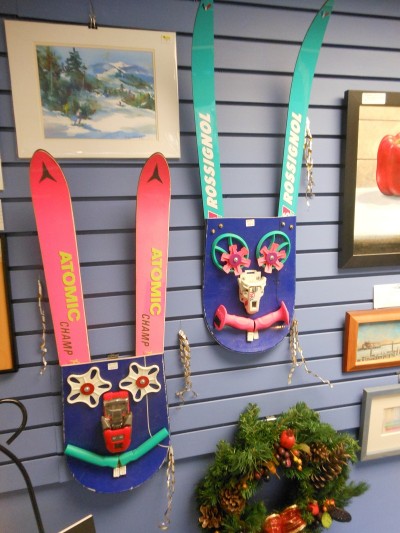
Old skis and snowboards have many uses.
They spring up all over ski country and beyond. After providing miles of runs they’re morphed into patio furniture. At one time they lifted many over rails, ramps and jumps. But today, they’ll hold bottles of wine.
From coat racks to canvas, skis and snowboards get second lives as recycled material for those with clever hands.
“We try to recycle twenty-five thousand skis and snowboards every year,” says Mike Bellino, owner of skichair.com in Millbury, Massachusetts. That’s on top of the 25,000 or so golf clubs, bats, hockey sticks and other things that carve and swing getting new lives as bottle owners, benches, shot skis, Adirondack ski chairs and other furniture and gift items.
He gets the gear from manufacturers and the public.
The idea came about in the early 1990s when Bellino was working at a bike and ski shop. He was also a recreational ski racer and during an apres ski beer he lamented to a buddy that he needed some outdoor furniture for his dock outside his lakefront home.
He told his friend he was going to build a chair out of skis. So, he was able to get a dozen skis, brought them home and built his chair. Eventually friends and family wanted some for themselves. Next thing you know, his hobby turned into a business.
Not only can skiers and riders park their tired kiesters in chairs, they can also view skis and snowboards as part of art.
Sure, old ski lift chairs and gondolas are reinvented as plant holders out on alpine front yards, but those skis and boards, poles and bindings can also be used to make cute snow bunnies.
That’s what a husband and wife teams in Brownfield, Maine does as part of their artwork. Joe Keller and Heather MacLoud make them out of donated and discarded gear.
The bunny ears are skis while the face is the tip of a snowboard. The eyes are ski baskets while the mouth is made from ski pole grips. The nose is a piece of a binding.
Another artist that uses skis as a canvas is J.P. Goodwin of Silver Lake, New Hampshire.
“All of us are looking for something new to create,” she said.
She paints on skis that have had their bindings removed, and have been sandblasted, filled and primed.
She transforms it into a decorative ski. Goodwin uses acrylic to paint the skis that come in ornamental and ski-specific themes. Choosing between a vertical or horizontal design, it takes her a few hours to paint the ski that is then sprayed and can be hung inside or outside.
“The challenge is to create a design that fits the format,” she said.
Goodwin’s art and skiing are tightly intertwined. Growing up in Marblehead, Massachusetts she came up to the White Mountains with her family and learned to ski in the 1950s at Black Mountain in Jackson, New Hampshire because her brother John Polando was assistant ski school director there.
Her husband, Tom Rogers, made his first turns at Cranmore in North Conway, New Hampshire and today their seven “walking grandchildren” all learned to ski at King Pine where Goodwin’s a ski instructor.
And her path to teaching turns at King Pine came several years ago while she was teaching a drawing class. One of her students was a ski instructor at the East Madison, New Hampshire ski area and convinced her to give it a shot.
She did, and now she’s also instrumental in rounding up those old skis and boards for creative types.
Goodwin works with graphite, oil and watercolor, As an artist and instructor is struck by the motions of skiers and snowboarders.
“When done well, snowboarding is an incredibly graceful sport,” she said “I find it very interesting to interpret the way people move when they ski or snowboard. It is very different than walking. As an instructor, I’m always looking at balance.”
Image by Marty Basch
 Your Privacy Choices
Your Privacy Choices
 The
The